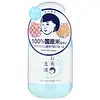What's inside
What's inside
 Key Ingredients
Key Ingredients

 Benefits
Benefits

 Concerns
Concerns

 Ingredients Side-by-side
Ingredients Side-by-side

Kaolin
AbrasiveMalt Flour
Skin ConditioningSodium C14-16 Olefin Sulfonate
CleansingDextrin
AbsorbentRice Ferment Lees
HumectantOryza Sativa Bran Oil
EmollientGlycosphingolipids
EmollientOryza Sativa Bran Extract
Skin ConditioningButylene Glycol
HumectantArginine
MaskingGlycerin
HumectantHydrogenated Lecithin
EmulsifyingHydrogenated Lysolecithin
EmulsifyingGuar Hydroxypropyltrimonium Chloride
Skin ConditioningPentylene Glycol
Skin ConditioningWater
Skin ConditioningMethylparaben
PreservativeEthylparaben
PreservativePhenoxyethanol
PreservativeKaolin, Malt Flour, Sodium C14-16 Olefin Sulfonate, Dextrin, Rice Ferment Lees, Oryza Sativa Bran Oil, Glycosphingolipids, Oryza Sativa Bran Extract, Butylene Glycol, Arginine, Glycerin, Hydrogenated Lecithin, Hydrogenated Lysolecithin, Guar Hydroxypropyltrimonium Chloride, Pentylene Glycol, Water, Methylparaben, Ethylparaben, Phenoxyethanol
Carrageenan
Silk
Methicone
EmollientIsostearyl Alcohol
EmollientBHT
AntioxidantLactic Acid
BufferingSodium Myristoyl Glutamate
CleansingTea-Lauroyl Glutamate
CleansingLipase
Skin ConditioningTalc
AbrasiveProtease
ExfoliatingSodium Cocoyl Isethionate
CleansingSodium Lauroyl Glutamate
Tar Oil
MaskingPotassium Hydroxide
BufferingSodium C14-16 Olefin Sulfonate
CleansingWater
Skin ConditioningPotassium Laurate
EmulsifyingGlyceryl Myristyl Lauroyl Glutamate
HumectantDipropylene Glycol
HumectantLactobacillus
Skin ConditioningPolyquaternium-51
Skin ConditioningButylene Glycol
HumectantAlcohol Denat.
AntimicrobialMethylparaben
PreservativeSodium Laurate
CleansingEthyl Glucoside
HumectantSodium Hyaluronate
HumectantLauryl Laurate
Skin ConditioningPhenoxyethanol
PreservativePotassium Oxide
BufferingBrassica Campestris Extract
Skin ConditioningSodium C14-18 Olefin Sulfonate
CleansingCarrageenan, Silk, Methicone, Isostearyl Alcohol, BHT, Lactic Acid, Sodium Myristoyl Glutamate, Tea-Lauroyl Glutamate, Lipase, Talc, Protease, Sodium Cocoyl Isethionate, Sodium Lauroyl Glutamate, Tar Oil, Potassium Hydroxide, Sodium C14-16 Olefin Sulfonate, Water, Potassium Laurate, Glyceryl Myristyl Lauroyl Glutamate, Dipropylene Glycol, Lactobacillus, Polyquaternium-51, Butylene Glycol, Alcohol Denat., Methylparaben, Sodium Laurate, Ethyl Glucoside, Sodium Hyaluronate, Lauryl Laurate, Phenoxyethanol, Potassium Oxide, Brassica Campestris Extract, Sodium C14-18 Olefin Sulfonate
Alternatives
Ingredients Explained
These ingredients are found in both products.
Ingredients higher up in an ingredient list are typically present in a larger amount.
Butylene Glycol (or BG) is used within cosmetic products for a few different reasons:
Overall, Butylene Glycol is a safe and well-rounded ingredient that works well with other ingredients.
Though this ingredient works well with most skin types, some people with sensitive skin may experience a reaction such as allergic rashes, closed comedones, or itchiness.
Learn more about Butylene GlycolMethylparaben is a preservative and is a paraben. It is used to prevent the growth of fungus, mold, and other harmful bacteria. Parabens are chemicals used as preservatives in both cosmetics and food.
Methylparaben can be synthetically created. It can also be found naturally in some fruits, such as blueberries.
Oftentimes, Methylparaben is combined with other parabens to help increase the shelf life.
The safety of Methylparaben is currently being studied. While ongoing studies are looking into the safety of parabens, the results have been very mixed. Some studies have not found Methylparaben to be harmful.
Learn more about MethylparabenPhenoxyethanol is a preservative that has germicide, antimicrobial, and aromatic properties. Studies show that phenoxyethanol can prevent microbial growth. By itself, it has a scent that is similar to that of a rose.
It's often used in formulations along with Caprylyl Glycol to preserve the shelf life of products.
Sodium C14-16 Olefin Sulfonate is a cleansing agent made from a mixture of long chain sulfonate salts. It can also help produce foam.
This ingredient may be drying. We recommend speaking with a professional if you have concerns.
Water. It's the most common cosmetic ingredient of all. You'll usually see it at the top of ingredient lists, meaning that it makes up the largest part of the product.
So why is it so popular? Water most often acts as a solvent - this means that it helps dissolve other ingredients into the formulation.
You'll also recognize water as that liquid we all need to stay alive. If you see this, drink a glass of water. Stay hydrated!
Learn more about Water